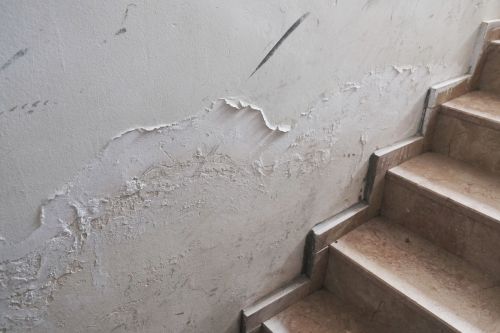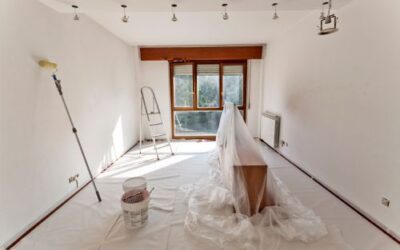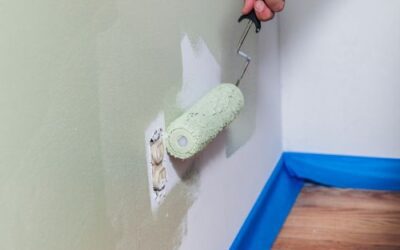When choosing a paint to protect walls from damp, it is important to know the difference between damp-proofing paint and mildew-proofing paint. Although often confused, they have different properties and uses that directly affect the durability and finish of surfaces. Applying the wrong type of paint can not only worsen the problem but also lead to additional repair costs. In this article we explain their differences, benefits and when to use each.
Contact our professionals
Damp-proof paint: Protection against leaks and condensation
Damp-proof paint is designed to prevent and treat moisture problems in walls and ceilings. Its main function is to block water absorption and prevent moisture from penetrating the surface. Its use is essential in spaces where dampness is recurrent, as it acts as a barrier that prevents water from causing damage to the paintwork or wall structure.
Main characteristics of damp-proof paint
- Forms a waterproof barrier that prevents water absorption.
- It is ideal for areas with condensation such as bathrooms, kitchens and basements.
- Helps prevent the appearance of damp stains and the deterioration of conventional paint.
- Some formulations include breathable agents that allow water to evaporate without compromising the paint.
- Can be used both indoors and outdoors, depending on the type of formulation.
When to use damp-proof paint
It is recommended in spaces where there are problems of capillarity, filtration or condensation. If walls have persistent damp stains or are flaking, applying damp-proof paint can be the solution to protect and improve their appearance. In addition, in cases where leaks come from the outside, it is advisable to identify the cause and solve it before applying the paint, to avoid recurring problems.
Anti-mould paint: Mould prevention and removal
Anti-mould paint is specifically formulated to prevent the growth of mould on surfaces exposed to moisture. It contains biocides and antifungal additives that prevent the growth of fungi and bacteria on walls and ceilings. The proliferation of mould on walls not only affects the aesthetics of the home, but can also be harmful to health, especially for people with allergies or respiratory problems.
Main characteristics of anti-mould paint
- Prevents the proliferation of mould and fungus in damp areas.
- It is ideal for enclosed spaces with poor ventilation.
- Can be applied over damp-proof paint for complete protection.
- Available in water-based and solvent-based versions, depending on surface requirements.
- Some formulations include protection against bacteria, making it ideal for hospitals and healthcare areas.
When to use anti-mould paint
If walls have black or greenish stains, bad odour or obvious signs of mould, it is advisable to use an anti-mould paint to eradicate the problem and prevent its reappearance. This is an excellent option for bathrooms, kitchens and poorly ventilated rooms, where dampness and lack of air circulation facilitate the proliferation of fungi. In some cases, it is advisable to use dehumidifiers to reduce the humidity in the room and improve the effectiveness of the paint.
Key differences between damp-proof paint and anti-mould paint
| Featurres | Damp-proof paint | Mould-proof paint |
|---|---|---|
| Main function | Blocks moisture | Prevents and eliminates mould and mildew |
| Recommended use | Leaky or condensing walls | Areas with recurring mould and mildew |
| Composition | Waterproof barrier | Biocides and antifungals |
| Ideal application | Bathrooms, kitchens, basements | Poorly ventilated spaces |
| Finish | Matt, breathable | White, various colours |
Can both paints be combined?
Yes, in many cases it is advisable to first apply a damp-proof paint to block water absorption and, once dry, use anti-mould paint to prevent the proliferation of fungus. This provides complete protection against moisture and its side effects. This combination is especially useful in humid climates or in areas where ventilation is insufficient.
In Bartolomé Bas Pinturas we offer you specialised advice and high quality products to solve any humidity problem in your walls. Contact us and discover the best solution for your home.
Other publications that may interest you
Paint suitable for basements and poorly ventilated rooms
Basements, storerooms or garages have unique conditions: poor ventilation, high humidity and increased risk of mould or condensation. Using conventional paint in these spaces is a common mistake that leads to ephemeral finishes and health problems due to fungi or...
How often should a house be painted depending on its use?
The frequency with which you should paint a house is not always the same. It depends on several factors: the use given to each room, the quality of the paint used, exposure to light or humidity, and even the colour. In this guide we explain how often you should renew...
Tips for painting a room without staining doors and sockets
Painting a room may seem like a simple task, but without the right preparation it's easy to end up with splashes on doors, sockets, switches and even skirting boards. If you want a clean, professional finish, we've got the best tips to avoid stains and save you...




